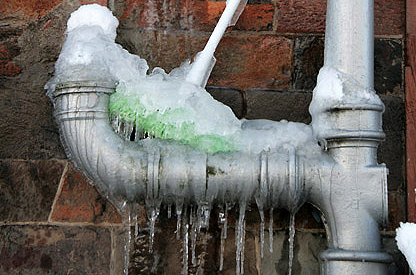Protecting Pipes from Cold Weather Damage: Essential Tips
Protecting Pipes from Cold Weather Damage: Essential Tips
Blog Article
The article further down in relation to Helpful Tips to Prevent Frozen Pipes this Winter is amazingly intriguing. Give it a go and draw your own personal assumptions.

Winter can damage your pipes, especially by freezing pipelines. Right here's exactly how to prevent it from happening and what to do if it does.
Introduction
As temperature levels decline, the danger of frozen pipelines increases, possibly resulting in pricey repairs and water damage. Understanding just how to prevent icy pipes is vital for house owners in chilly environments.
Prevention Tips
Protecting vulnerable pipelines
Wrap pipelines in insulation sleeves or utilize warmth tape to secure them from freezing temperatures. Focus on pipelines in unheated or outside areas of the home.
Home heating techniques
Keep indoor areas sufficiently heated up, particularly locations with pipes. Open up cabinet doors to allow warm air to flow around pipelines under sinks.
Just how to identify frozen pipes
Try to find decreased water flow from faucets, unusual odors or noises from pipelines, and noticeable frost on exposed pipes.
Long-Term Solutions
Structural adjustments
Think about rerouting pipes far from exterior wall surfaces or unheated areas. Include extra insulation to attics, cellars, and crawl spaces.
Upgrading insulation
Purchase top notch insulation for pipelines, attics, and walls. Appropriate insulation helps maintain regular temperatures and reduces the threat of frozen pipelines.
Shielding Exterior Pipes
Garden tubes and outside faucets
Detach and drain pipes garden hoses prior to winter. Install frost-proof faucets or cover outdoor taps with insulated caps.
Comprehending Icy Pipes
What creates pipes to freeze?
Pipes ice up when subjected to temperatures below 32 ° F (0 ° C) for prolonged periods. As water inside the pipes freezes, it broadens, taxing the pipe wall surfaces and possibly causing them to burst.
Risks and damages
Icy pipes can bring about water disruptions, residential or commercial property damage, and expensive repair services. Ruptured pipelines can flood homes and cause considerable structural damages.
Indications of Frozen Pipes
Recognizing icy pipes early can prevent them from bursting.
What to Do If Your Pipelines Freeze
Immediate actions to take
If you think icy pipelines, keep taps available to soothe stress as the ice melts. Make use of a hairdryer or towels soaked in warm water to thaw pipes gradually.
Final thought
Avoiding icy pipes needs positive measures and fast responses. By comprehending the reasons, indications, and safety nets, property owners can secure their pipes during winter.
6 Proven Ways to Prevent Frozen Pipes and Protect Your Home
Disconnect and Drain Garden Hoses
Before winter arrives, start by disconnecting your garden hoses and draining any remaining water. Close the shut-off valves that supply outdoor hose bibs and leave the outdoor faucet open to allow any residual water to drain. For extra protection, consider using faucet covers throughout the colder months. It’s also important to drain water from any sprinkler supply lines following the manufacturer’s directions.
Insulate Exposed Pipes
Insulating your pipes is an effective way to prevent freezing. Pipe insulation is readily available at home improvement stores and is relatively inexpensive. Pay close attention to pipes in unheated areas such as the attic, basement, crawl spaces, or garage. Apply foam insulation generously to create a buffer against the cold. You can also wrap your pipes in heat tape or thermostat-controlled heat cables for added warmth.
Seal Air Leaks
Inspect your home for any cracks or openings that could let in cold air. Seal any holes around the piping in interior or exterior walls, as well as the sill plates where your home rests on its foundation. Additionally, make sure to keep your garage door closed unless you’re entering or exiting. Leaving it open creates a significant air leak that can lead to frozen pipes.
Allow Warm Air Circulation
During cold snaps, it’s essential to allow warm air to circulate evenly throughout your home. Leave interior doors ajar to promote better airflow. Open kitchen and bathroom cabinets to help distribute heat consistently around the rooms. If you have small children or pets, be sure to remove any household chemicals or potentially harmful cleaners from open cabinets for safety.
Let Faucets Drip
A small trickle of water can make a big difference in preventing ice formation inside your pipes. When temperatures drop significantly, start a drip of water from all faucets served by exposed pipes. This continuous flow helps prevent the water from freezing. Additionally, running a few faucets slightly can relieve pressure inside the pipes, reducing the chances of a rupture if the water inside does freeze.
https://choateshvac.com/6-proven-ways-to-prevent-frozen-pipes-and-protect-your-home/

Do you really like reading up on Prevent Frozen Pipes ? Try to leave a remark further down. We will be glad to hear your thinking about this blog entry. Hoping to see you back again soon. Enjoyed reading our article? Please share it. Let other people locate it. I appreciate your readership.
Call Today Report this page